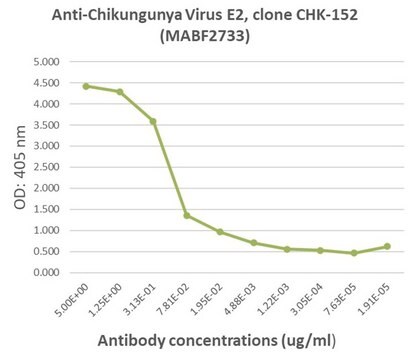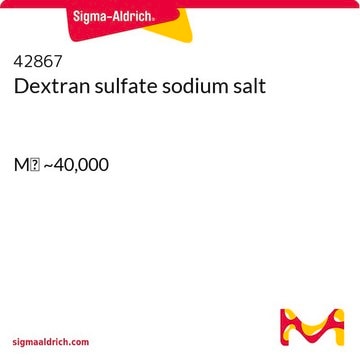General description
Structural polyprotein (UniProt: Q8QZ72; also known as p130) is encoded by the MAYVgp3 gene (Gene ID: 935141) in Mayaro virus. Following its synthesis it is cleaved into the following six chains: Capsid protein (aa 1-258), Precursor of protein E3/E2 (aa 259-746), Assembly protein E3 (aa 259-324), Spike glycoprotein E2 (aa 325-746), 6K protein (aa 747-806), and Spike glycoprotein E1 (aa 807-1242). Mayaro virus (MAYV) is a mosquito-transmitted arthritogenic alphavirus in the Togaviridae family of positive-stranded RNA viruses. Its envelope glycoproteins associate in the endoplasmic reticulum and form a heterotrimer comprised of the E3, E2, and E1 proteins. E2 is a single-pass type I membrane protein that plays a role in viral attachment to target host cell, by binding to the cell receptor. It is synthesized as a p62 precursor (precursor of protein E3/E2), which is then processed by furin at the cell membrane just before virion budding, giving rise to E2-E1 heterodimer. The p62-E1 heterodimer is shown to be stable, whereas E2-E1 is unstable and dissociates at low pH. It has been reported that p62 is processed at the last step, presumably to avoid E1 fusion activation before its final export to cell surface. The C-terminus region of E2 contains a transitory transmembrane region that is disrupted by palmitoylation and results in reorientation of the C-terminal tail from lumenal to cytoplasmic side. Clone MAY-134 offers protection against lethal effects of MAYV in a murine model when injected one day prior to virus inoculation. However, its protective effects are significantly reduced when injected two days post infection. It also promotes phagocytosis of MAYV antigen-coated beads in murine neutrophils and monocytes. This clone displays higher protective activity as IgG2a than IgG1 even though their neutralizing activity in vitro and half-lives in vivo were identical. (Ref.: Earnest, JT., et al. (2019). J. Exp. Med. 216(10); 2282-2301).
Specificity
Clone MAY-134 is a mouse monoclonal antibody that detects E2 protein of Mayaro virus. It targets an epitope within the B domain in the extracellular region.
Immunogen
MAYV strain CH and boosted twice with recombinant, bacterially produced MAYV E2 ectodomain (amino acids 1-340) in Freund s incomplete adjuvant.
Application
Quality Control Testing
Evaluated by ELISA with recombinant Mayaro virus E2 protein.
ELISA Analysis (ELISA): Various dilutions of this antibody detected recombinant E2 protein of Mayaro virus CH (strain Peru).
Tested Applications
Neutralizing: A representative lot neutralized Mayaro Virus E2 in Neutralizing applications (Earnest, J.T., et al. (2019). J Exp Med. 216(10): 2282-2301).
Note: Actual optimal working dilutions must be determined by end user as specimens, and experimental conditions may vary with the end user
Anti-Mayaro Virus E2, clone MAYV-134 , Cat. No. MABF3046, is a mouse monoclonal antibody that detects E2 protein of Mayaro virus CH and is tested for use in ELISA and Neutralizing applications.
Physical form
Purified mouse monoclonal antibody IgG2a in PBS without azide.
Storage and Stability
Store at -10°C to -25°C. Handling Recommendations: Upon receipt and prior to removing the cap, centrifuge the vial and gently mix the solution. Aliquot into microcentrifuge tubes and store at -20°C. Avoid repeated freeze/thaw cycles, which may damage IgG and affect product performance.
Other Notes
Concentration: Please refer to the Certificate of Analysis for the lot-specific concentration.
Disclaimer
Unless otherwise stated in our catalog or other company documentation accompanying the product(s), our products are intended for research use only and are not to be used for any other purpose, which includes but is not limited to, unauthorized commercial uses, in vitro diagnostic uses, ex vivo or in vivo therapeutic uses or any type of consumption or application to humans or animals.









